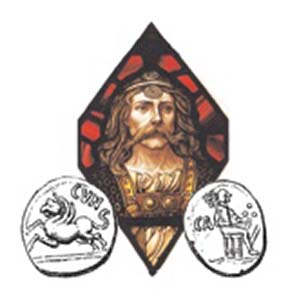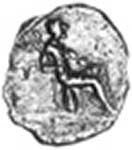by Chris Rudd
October 13, 2011 – Caratacus ‘beloved chief’, the famous British freedom-fighter, waged guerrilla warfare against the Roman army for eight years, until he was betrayed in AD 51 by Cartimandua ‘strong pony’, queen of the Brigantes.
Caratacus silver unit in Bibliothèque Nationale, Paris, incorrectly attributed to Cunobelinus by Ernest Muret in 1889 and Sir John Evans in 1890. Source: Detail from stained glass window in Moot Hall, Colchester Town Hall, photo (C) Miranda Aldhouse-Green, Boudica Britannia, 2006; coin drawing of BN 9564 by Paul Sellier in J.Evans, The Coins of the Ancient Britons, 1890.
For 120 years a coin type has been wrongly attributed to King Cunobelinus, the father of Caratacus, because the French numismatist, Ernest Muret, had originally read the inscription on the Paris specimen as CAM – short for Camulodunon (modern Colchester), the capital of Cunobelinus. Sir John Evans (1823-1908), the father of ancient British numismatics, also gave the coin to Cunobelinus in his 1890 Supplement to The Coins of the Ancient Britons.
Ten years ago Dr Philip de Jersey, an archaeologist in Guernsey and former keeper of the Celtic Coin Index, challenged Muret’s reading and said that the legend appeared to be CAR. He also said: “There are no findspots, and one could argue that the attribution to Cunobelin is debatable, despite the broad stylistic similarities and the difficulty of suggesting a viable alternative” (Cunobelin’s Silver, Britannia 32, 2001, 18). Earlier this year a findspot and a ‘viable alternative’ both emerged.
Caratacus silver unit, c. AD 40-43, found in Hertfordshire and restored to Caratacus by Elizabeth Cottam in July, 2011. Only three others recorded. Photos: Chris Rudd.
A metal detectorist unearthed another specimen of this elusive silver coin – only the fourth known – in Hertfordshire, heartland of the Catuvellauni tribe, probably at a site near Hemel Hempstead, where Evans lived and worked most of his life. The numismatist Elizabeth Cottam acquired this coin, realised that the name on the reverse was indeed CAR not CAM, and published it as ‘an unrecognised coin of Caratacus’ (Chris Rudd List 118, July 2001, 5). “He fought so hard for Britain,” says Mrs Cottam, “I think it’s only fair that he gets the credit for issuing this coin, not his dad.”
As “freedom-fighter” Caratacus is very popular in modern times. But do you know the song “The Court of King Caractacus” by Rolf Harris?






